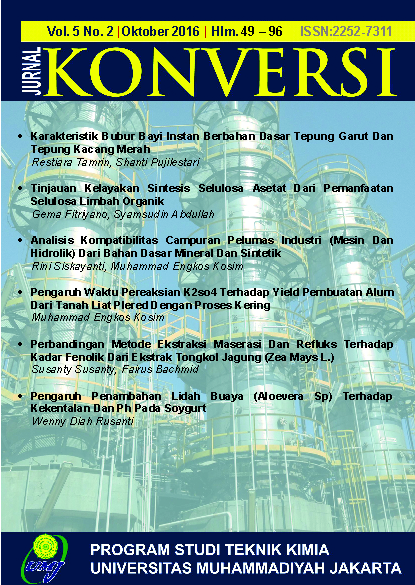PENGARUH WAKTU PEREAKSIAN K2SO4 TERHADAP YIELD PEMBUATAN ALUM DARI TANAH LIAT PLERED DENGAN PROSES KERING
Main Article Content
Abstract
Selama ini pemanfaatan mineral tanah liat baru sebatas untuk bahan baku pabrik keramik, semen, genteng dan batu bata, padahal tanah liat dapat didiversifikasikan nilai ekonomisnya untuk keperluan lain seperti pembuatan Alum yang dapat digunakan untuk proses pengolahan air. Penelitian ini bertujuan untuk mencari kondisi optimum dari waktu reaksi terhadap yield pembuatan alum dari tanah liat dengan proses kering. Penelitian ini merupakan eksperimen untuk menentukan kondisi operasi pada pembuatan alum dari tanah liat, analisis korelasi antara waktu reaksi dan yield pembentukan alum diolah menggunakan metode persamaan “Least Square”. Hasil penelitian didapatkan waktu reaksi Kalium Sulfat maksimum pembentukan Alum berlangsung selama 1.75 jam (105 menit) dengan yield 76.7%, sedangkan waktu reaksi optimum terjadi pada waktu 0,167 jam (10 menit) dengan yield sebesar 68,4%. Kata kunci: alum, kalium sulfat, least square, proses alum, proses kering, tanah liat, yield.
Article Details
Issue
Section
Articles
Authors who publish with this journal agree to the following terms:
- Authors retain copyright and grant the journal right of first publication with the work simultaneously licensed under a Creative Commons Attribution License that allows others to share the work with an acknowledgement of the work's authorship and initial publication in this journal.
- Authors are able to enter into separate, additional contractual arrangements for the non-exclusive distribution of the journal's published version of the work (e.g., post it to an institutional repository or publish it in a book), with an acknowledgement of its initial publication in this journal.
- Authors are permitted and encouraged to post their work online (e.g., in institutional repositories or on their website) prior to and during the submission process, as it can lead to productive exchanges, as well as earlier and greater citation of published work (See The Effect of Open Access).
